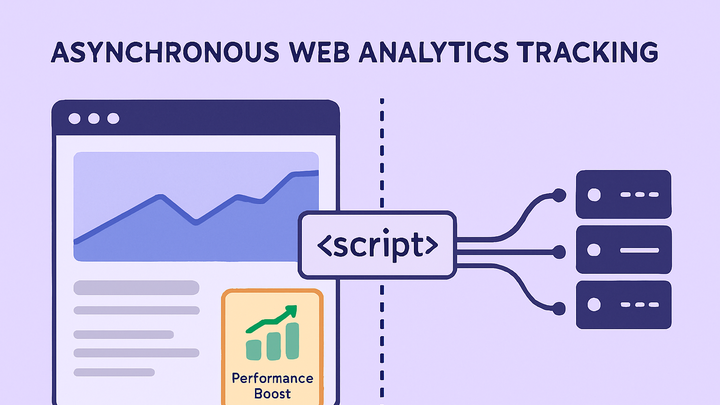Published on 2025-06-22T01:54:07Z
What is Asynchronous Tracking? Examples with PlainSignal and GA4
Asynchronous Tracking is a technique in web analytics where tracking scripts are loaded in parallel with
page content. Unlike synchronous tags that block rendering until fully loaded, asynchronous tags allow the
page to continue rendering while the tracking library loads in the background. This improves page load
performance, enhances user experience, and ensures more reliable data capture, even under poor network
conditions. Leading platforms like Google Analytics 4 (GA4) and PlainSignal (a cookie-free simple
analytics solution) use asynchronous methods by default to minimize overhead. By leveraging
async or defer attributes, or specialized loader scripts, asynchronous tracking
seamlessly sends user interactions to analytics servers without compromising site speed. Below, we explore
how asynchronous tracking works, its benefits, implementation patterns, and best practices in modern
analytics.
Asynchronous tracking
A non-blocking method of loading and firing analytics scripts to boost page performance and ensure reliable data capture.
Definition and Core Principles
Explore what asynchronous tracking is, how it contrasts against synchronous, and why it’s core to modern analytics.
-
What is asynchronous tracking?
Asynchronous tracking loads analytics scripts in parallel with the main page content to avoid blocking rendering. It sends events via JavaScript once the script is available, ensuring the page remains responsive.
-
Synchronous vs asynchronous
Comparison of traditional synchronous tracking, which halts rendering until execution, against asynchronous which runs in the background.
-
Synchronous tracking
Loads and executes the script immediately, blocking page rendering until completion, which can degrade performance.
-
Asynchronous tracking
Loads the script in parallel or after parsing the HTML, allowing page content to render without waiting for the analytics code.
-
Benefits of Asynchronous Tracking
Key advantages that make asynchronous tracking the preferred choice for performance-focused analytics.
-
Improved page load performance
Non-blocking script loading reduces time to first paint and overall site speed scores in tools like Lighthouse.
-
Enhanced user experience
By avoiding render delays, visitors see content faster, reducing bounce rates and improving engagement metrics.
-
Reliable data capture
Background execution ensures that tracking continues even if parts of the page fail to load or scripts error out.
Implementation Strategies
Overview of common patterns to implement asynchronous tracking in analytics platforms and websites.
-
Using PlainSignal (cookie-free simple analytics)
PlainSignal provides a lightweight, asynchronous loader by default. Embed the following code snippet into your <head> to start tracking without cookies.
-
Code snippet
<link rel='preconnect' href='//eu.plainsignal.com/' crossorigin /> <script defer data-do='yourwebsitedomain.com' data-id='0GQV1xmtzQQ' data-api='//eu.plainsignal.com' src='//cdn.plainsignal.com/plainsignal-min.js'></script>
-
-
Implementing in google analytics 4
GA4’s Global Site Tag (
gtag.js) uses async loading. Place the script in the <head> to fire events as soon as possible without blocking.-
GA4 snippet
<script async src='https://www.googletagmanager.com/gtag/js?id=G-XXXXX'></script> <script> window.dataLayer = window.dataLayer || []; function gtag(){dataLayer.push(arguments);} gtag('js', new Date()); gtag('config', 'G-XXXXX'); </script>
-
-
Using async vs defer attributes
asyncloads the script asynchronously and executes it as soon as it’s downloaded.deferloads the script asynchronously but delays execution until after HTML parsing.
Best Practices and Pitfalls
Recommended guidelines and common mistakes to avoid when using asynchronous tracking.
-
Script placement
For async, place scripts high in <head> to capture early events. For deferred scripts, ensure critical content isn’t delayed.
-
Fallbacks and error handling
Implement error callbacks or timeout logic to retry tracking if the primary script fails to load.
-
Error events
Use
onerrorcallbacks to detect script load failures and fallback to alternative endpoints. -
Retries
Set a retry mechanism with capped attempts to avoid infinite loops.
-
-
Validating data integrity
Use browser dev tools, network logs, and platform debugging modes to ensure tracking hits are sent correctly.
Monitoring and Debugging Asynchronous Tracking
Techniques for verifying that your asynchronous tracking is firing correctly and measuring performance.
-
Browser developer tools
Inspect Network tab for analytics requests, check timing, payload and response statuses.
-
Platform debug modes
Enable debug mode in GA4 to view events real-time. PlainSignal logs events in its dashboard with timestamps.
-
Synthetic monitoring
Use tools like Lighthouse, WebPageTest or synthetic user flows to ensure analytics scripts load under different conditions.
